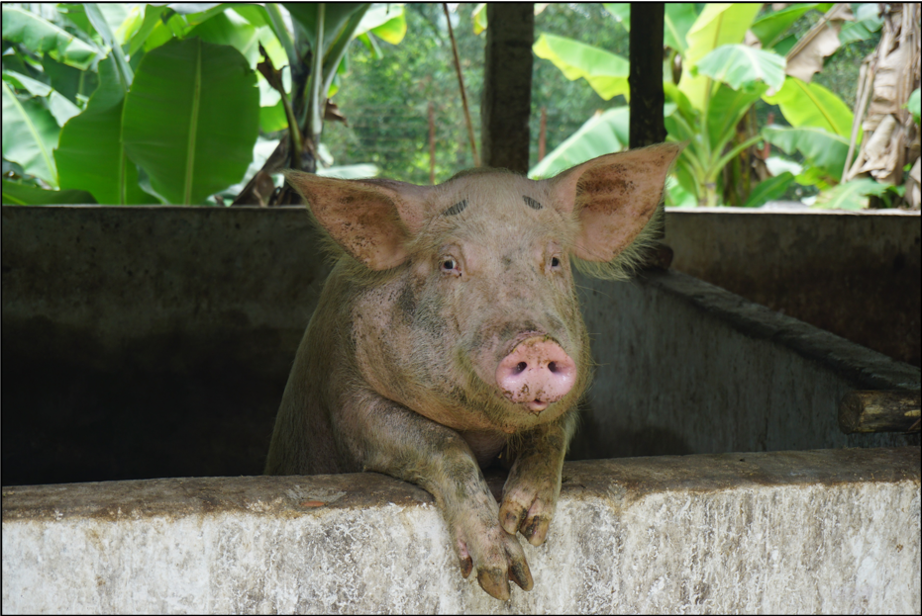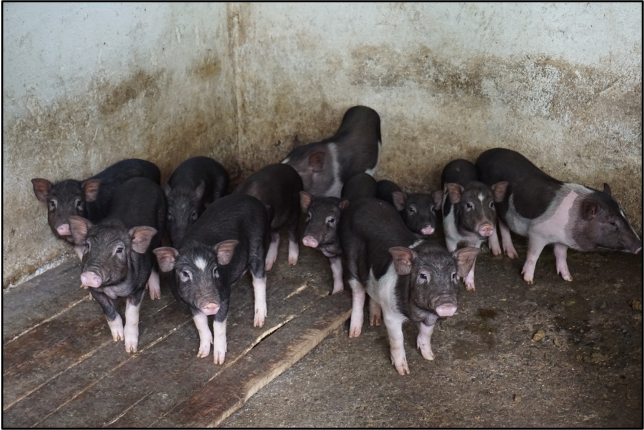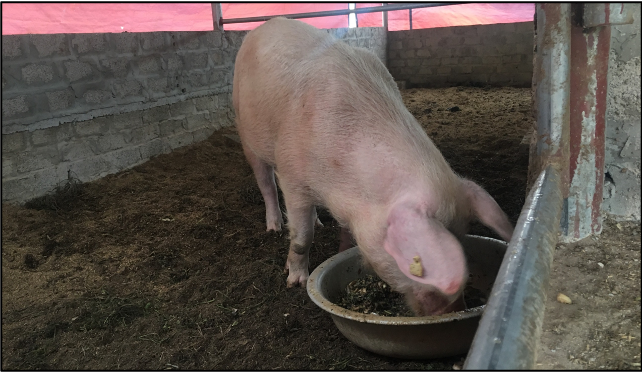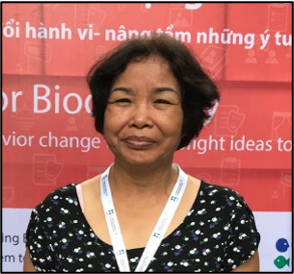
In a small town in northern Vietnam, where the green hillsides crest and slope in unending layers, Nguyen Thi Tuyet has seen a lot of change in her 65 years. But the one constant has been that life in her village centers on agriculture.
Most people in the Vo Nhai district in Thai Nguyen province spend their days raising pigs, chickens, or cattle, and tending to tea, corn, or rice field paddies. But last year, swine fever raced through all 63 provinces in Vietnam. More than 23 percent of the country’s total pig population died. In a country where pork makes up three-quarters of total meat consumption and accounts for nearly 10 percent of the agricultural sector, this was a huge problem. And it was felt deeply in Ms. Tuyet’s community, where more than 360 families depend on pigs to make a living.
No one could have predicted the disease would sweep the country like it did. And while this outbreak was not a zoonotic disease (the kind of disease that jumps from animals to people) like COVID-19 is believed to be, it raises the importance of more environmentally and zoologically responsible practices to prevent future outbreaks. It also highlights the challenge of motivating farmers to adopt a new approach.
In many rural areas in Vietnam, pigs are raised in structures made of brick and concrete, often annexed to farmers’ homes. The amount of pigs in one of these annexes varies, but there can be as many as 30 pigs in one small space. The floors are typically made of cement, which damages the pigs’ hooves. The nonporous flooring also means that when the animals relieve themselves, there is nowhere for the waste to go. They often get sick from sitting in their own mess, which then spurs a need for antibiotics. Farmers resort to hosing down the sties, washing the waste out once or twice a day or moving it to biogas cellars. Even with this, the stink is inescapable. And the waste that gets washed out? It flows into the street gutters, and eventually, the river. The runoff contaminates local water supplies and upsets the ecological balance of river, leading to harmful algal blooms, dead zones, and the destruction of river wildlife.

As a former chairwoman of the Vo Nhai Women’s Union, Ms. Tuyet is passionate about community development. Although she retired in 2010, she hasn’t stopped working. Last year, she attended a training workshop in Ba Vi National Park, near Hanoi, about sustainable farming practices. While there, Ms. Tuyet and more than 20 others learned more about the problems that concrete-floored pigsties cause, and how a combination of science-based techniques and social marketing could pave the way for healthier, environmentally-friendly alternatives. The training was part of a series called Campaigning for Conservation (C4C) that Rare, an environmental nonprofit organization, runs with the support of Germany’s International Climate Initiative, to help practitioners solve social and environmental challenges facing their communities. Rare conducted the training in partnership with the Center 4 Creativity & Sustainability (CCS), a local agricultural and community development organization, as well as A Growing Culture, an organization that supports farmer-led solutions.
After the workshop, Ms. Tuyet and a team of more than 20 technicians who also attended the C4C training program decided to lead a campaign to change these harmful practices. Ms. Tuyet applied for — and won — a grant to advocate for and teach farmers about a better way to manage livestock using a living bio-bed.

Rather than concrete, the pigs are kept on a three-layer thick bed made of locally-sourced absorbent materials such as acacia or eucalyptus bark, bamboo foil and powder, sawdust, rice hulls, and dry leaves. The beds are sprayed with beneficial bacteria made from mold produced on the farm, warm water, molasses, and Lactobacillus (a culture made from milk). The bedding becomes ‘alive’ with these good bacteria, which break down manure and pig urine. The same bedding can stay for months, and it’s easy for farmers to produce more.

Loren Cardeli, executive director of A Growing Culture, says, “The idea is to co-infect instead of to disinfect. When we disinfect, we also kill the good bacteria, which can have negative effects, and actually end up making the problem worse.”
Healthier pigs lower the risk of diseases transferring from animals to humans, and also mean that farmers don’t have to spend as much money on antibiotics. Once the animal waste gets buried in the beds, the normally inescapable odor from pig sties disappears. Farmers don’t need to spray out the pig pens, eliminating the runoff that pollutes the water supply.
Back in the Thai Nguyen province, Ms. Tuyet got to work right away. With support from CCS, she started her campaign. She reached out to farmer unions, people’s committees, and individual farmers to set up sites to demonstrate the power of these bio-beds to help community members see — and smell — this remarkable technique for themselves.
And then the swine fever hit.
Pigs were sick and dying throughout the country. The government ordered millions of pigs to be culled to prevent the disease from spreading further. The demonstration sites closed because the government ordered pig farms to shut down. Pig farmers mourned these deaths and grew concerned about how they were supposed make up the economic losses.
With no pigs for the pig bedding, Ms. Tuyet could have given up. Instead, she decided to switch tactics. Even if there were no pigs now, the pigs would come back at some point. She thought it would still be worthwhile to get farmers to understand these methods and spark the incentives for a new approach to livestock management. Plus, pigs were not the only type of animals that could be raised on these bio-beds. From what Ms. Tuyet had learned, the bio-beds would work just as well for chickens and other farm animals.
She called on the Farmer Union to improve farm inspection and supervision, and to provide better information for how farmers can maintain more hygienic practices and educate them on disease prevention. She decided to focus the work entirely on her community (as opposed to a broader group of neighboring villages), spurring the renovation of demonstration sites and hosting workshops locally. She coordinated with local broadcasting stations to share information about livestock health and management more widely.
And she has noticed some changes. She says that, “local officials and farmers are more aware of the techniques and the benefits of living bio-beds. Farmers often talk to each other about the difference the bio-beds are making.”

Now, with the world on lockdown in the midst of a different pandemic, it is unclear at what point Ms. Tuyet’s efforts will pay off in visible ways. But Ms. Tuyet remains determined: “When pig farmers fully understand the advantages of the living bio-beds, they want to apply these methods to bring economic, social, and environmental benefits, along with improvements in short- and long-term health for their own families and for the whole society.”
Long Nguyen Hong, the director of CCS, who worked closely with Ms. Tuyet says, “The Vietnamese people are really resilient, and they take it in their stride. They also have close-knit communities. In rural areas, you can rely on your relatives — you can rely on family.”
With COVID-19 halting life as most of the world knows it, the lessons from this swine fever outbreak feel especially salient. As humans continue to encroach on animal habitats, we are likely to see more novel viruses emerge. According to the CDC, “Scientists estimate that more than 6 out of every 10 known infectious diseases in people can be spread from animals, and 3 out of every 4 new or emerging infectious diseases in people come from animals.”
Improving livestock management and sanitation is part of keeping animals, people, and the environment healthy. Livestock that are genetically similar and kept close together, as has typically been the case with pig production in Vietnam and other parts of Asia, increases the likelihood of disease occurring and spreading. But by normalizing healthier agricultural practices, safeguarding environmental ecosystems, and improving economic opportunity and resilience, solutions are more likely to stick in the long run. “We’re not good at predicting what’s to come, but the best model is to build a resilient system. It becomes an insurance policy,” says Cardeli.
Ms. Tuyet knows that people are wary about new technology and concerned about economic efficiency. Asking people to change the methods they’ve used to farm for generations is not easy. But she feels a sense of trust and responsibility in her community. She hopes that this living bio-beds campaign will be successful so that local authorities and farmers will apply these principles and techniques to protect the environment and improve her community’s quality of life.